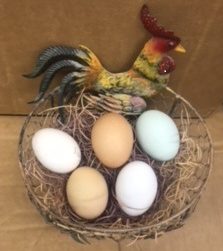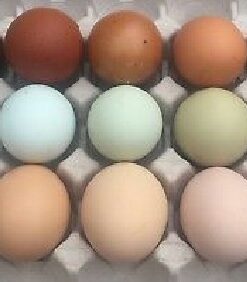Ayam Cemani Eggs
The Mysterious Beginning of a Rare and Exotic Breed
Among the most exotic and visually stunning chicken breeds in the world, the Ayam Cemani Eggs stands out not just for its striking appearance, but for the deep cultural legends and rarity surrounding it. Known as the “Lamborghini of poultry,” this Indonesian breed is prized for its entirely black coloration—feathers, skin, organs, and even bones. But interest in this bird often begins at the source: the Ayam Cemani eggs.
🥚 What Are Ayam Cemani Eggs?
Ayam Cemani eggs are the fertile or table eggs laid by Ayam Cemani hens. Despite the breed’s jet-black appearance, the eggs themselves are surprisingly not black. Instead, they are typically:
-
Medium to large in size
-
Smooth-shelled and slightly glossy
This often surprises first-time keepers, as many assume the eggs would be dark or even black to match the breed’s appearance. However, the black pigmentation (fibromelanosis) that gives the breed its inky coloring does not affect the eggshells.
🔍 What Makes Ayam Cemani Eggs Special?
1. Rarity and Exclusivity
Purebred Ayam Cemani hens are known for being infrequent layers, typically producing 60–100 eggs per year—far fewer than standard layers like Leghorns or Rhode Islands. This limited output makes their fertile hatching eggs highly sought after by breeders and collectors.
2. Genetic Purity
Because Ayam Cemani chickens are a rare and heritage breed, eggs from verified purebred hens carry genetic value. Breeders around the world seek out high-quality hatching eggs to preserve bloodlines and maintain the breed’s signature traits.
3. Symbolic and Cultural Value
In Indonesia, the Ayam Cemani is considered a sacred bird, often associated with spiritual rituals, prosperity, and protection. The eggs themselves may carry symbolic importance in traditional ceremonies.
🐣 Hatching Ayam Cemani Eggs
If you’re planning to hatch Ayam Cemani eggs, here’s what you need to know:
-
Incubation period: ~21 days
-
Ideal temperature: 99.5°F (37.5°C)
-
Humidity: 45–55% until day 18, then increase to 65–70% for hatching
-
Turning: Eggs should be turned at least 3 times a day until lockdown
-
Candling: Can be done around day 7 to check for embryo development
Because of the breed’s value, it’s essential to source hatching eggs from reputable breeders who practice proper flock management and breed only pure Ayam Cemani stock.
🛑 Common Misconceptions About Ayam Cemani Eggs
-
“Are the eggs black?”
No. While the chickens are black inside and out due to fibromelanosis, the eggs are a light cream or tan color. -
“Do they taste different?”
Not significantly. The flavor is similar to other farm-fresh eggs, though some keepers report a slightly richer yolk depending on diet and environment. -
“Are they magical or medicinal?”
In some cultures, the eggs (and birds) are believed to possess spiritual or healing powers. Scientifically, however, they are regular eggs in terms of nutrition.
💡 Tips for Buying Ayam Cemani Eggs
-
Buy from NPIP-certified breeders (in the U.S.) or trusted hatcheries
-
Ask for parent stock photos to verify coloration and breed quality
-
Ensure proper packaging for shipped eggs, as fertility can be affected by rough handling
-
Expect to pay a premium—pure Ayam Cemani hatching eggs can range from $10 to $30+ per egg
Final Thoughts
Ayam Cemani eggs are more than just the start of a rare chicken—they’re a window into one of the world’s most exotic and captivating poultry breeds. Whether you’re interested in hatching for breeding, preserving rare genetics, or simply want to add an element of mystery to your backyard flock, these eggs offer an unforgettable experience.
From their unassuming beige shells emerge some of the most striking birds on the planet—living shadows cloaked in feathers, born from humble beginnings.
Be the first to review “ayam cemani eggs” Cancel reply
Related products
Hatching Eggs
Hatching Eggs
Hatching Eggs
Hatching Eggs
Hatching Eggs
Hatching Eggs
Hatching Eggs
Hatching Eggs












Reviews
There are no reviews yet.